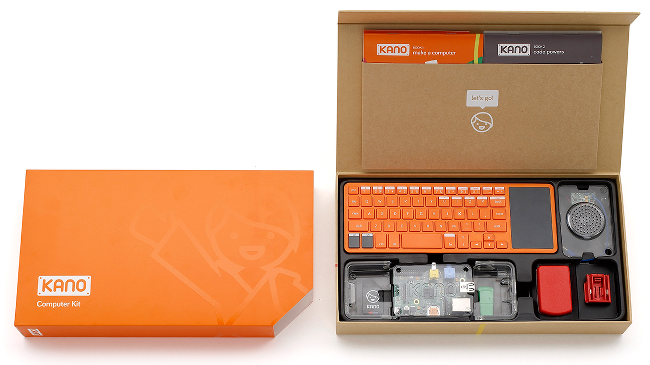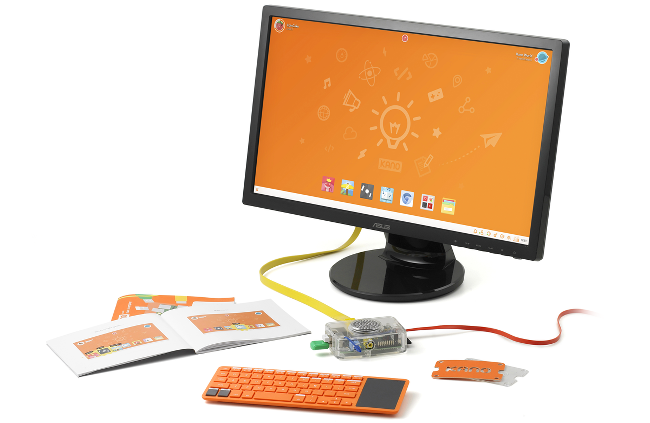Close-up of the projector built in to the Lenovo Yoga Table 2 Pro
A look at gadget happenings, as Lenovo reveals a tablet with a projector, Kano’s computer kit hits the market, Thync gets investment for its mind-altering wearable, and Toshiba exhibits an eerily lifelike robot.
Lenovo’s flexible new Yoga family
Lenovo has introduced three new products to the Yoga family: the Yoga 3 Pro, the Yoga Tablet 2 and the Yoga Tablet 2 Pro.
The Yoga 3 Pro comes with a new watchband hinge to make it sturdier even though it’s thinner and lighter than its predecessor, while the Yoga Tablet 2 has added a notch at the back to hang the tablet in an all-new position.
The real showstopper, though, is the Yoga Tablet 2 Pro: a 13-inch tablet with a built-in projector. The Pico projector embedded in the tablet’s side can project a 16:9 aspect ratio high-resolution image onto your chosen surface for a cinematic experience powered by mobile technology.

Lenovo’s Yoga Tablet 2 Pro with built-in projector
To couple this with audio fit for the view, Lenovo has included an 8W sound system and a tablet subwoofer – which could be a world first.
The Lenovo Yoga Tablet 2 Pro will be released later this month starting at €499 and, continuing the flexible nature of the Yoga range, all of these products are available on either Android or Windows.
Kano for kids can teach them the basics of computing
London-based start-up has released the Kano computer kit to market, inviting children aged six to 14 to get hands-on with computing and learn a thing or two about components and programming.
Inside a Kano kit comes a Raspberry Pi computer board to be assembled with a plastic case and speaker, plus a bright orange keyboard to start programming and a HDMI cable to connect to any compatible display.


Once the computer has been assembled – a process that takes all of about 15 minutes – Kano teaches users to modify code for simple games such as Snake, Pong and Minecraft using its own simplified visual programming language, Kano Blocks. This code is based on Python but has been built to resemble a jigsaw puzzle to teach users the logic of computing.
Colourful, clear booklets guide users young and old through the whole process and, once they get the hang of it, they can connect to the web, stream media or access email.
The €150 Kano computer kit is now available to buy online with free shipping to most countries, including Ireland.
Toshiba’s signing robot looks almost human
Toshiba Corporation revealed a lifelike communication android at CEATEC Japan 2014 in Makuhari Messe convention centre just outside Tokyo last week.
The android, named Aiko Chihira, has been built with an algorithm to co-ordinate the movement of 43 actuators in its joints, allowing it to move its arms and hands smoothly and use Japanese sign language.
Aiko Chihira is meant to look like a friendly young woman, complete with blinking eyes and a warm smile. It is believed that service robots such as this will have use in healthcare and welfare, or even as companions for the elderly.
The protoype demonstrated at the exhibition was developed in collaboration with aLab Inc, Osaka University, Shibaura Institute of Technology and Shonan Institute of Technology and the intention is to create a more sophisticated social robot by 2020, with enhanced sensing, speech synthesis, speech recognition and robotic control.
Thync investment for mood-altering wearable
Boston start-up Thync announced last week that it had raised US$13m from investors, including Khosla Ventures. The money pouring into this young company founded in 2011 will support the development of the Thync product, an apparently mood-altering wearable.
Thync has not yet been publicly revealed but the prototype device consists of two electrodes which connect to the user’s head to deliver carefully calibrated levels of electricity to the cranial nerves, the intensity of which can be adjusted via a Bluetooth-connected iPhone app. Two mood adjustments are promised by this technology: either an ‘energy vibe’ or a ‘calm vibe’.
If it sounds like the stuff of science-fiction, it is – just read Philp K Dick’s Do Androids Dream of Electric Sheep?
But, strange as it may seem to turn to an electronic device to alter your mood, is it any stranger than modern office-workers’ reliance on caffeine to get energised, or cigarettes and alcohol to calm down?
Electrical stimulation of the brain is already being explored as a method of improving memory and learning ability, and to treat head injuries and depression. These small doses of electricity are not to be confused with the old torturous methods of electro-shock therapy and bears a new name: transcranial direct-current stimulation, or tDCS.
Thync’s plan is to commercialise this area of neuroscience and take it directly to consumers by next year.
Paper-aeroplane machine-gun
Finally, YouTuber who appears to be quite an expert when it comes to constructing paper aeroplanes has developed something truly incredible: a paper-aeroplane machine-gun, or Papierflieger-Maschinenpistole in his native German tongue.
Most of the gun was constructed using parts fabricated by 3D-printing service Fabberhouse, and the rest were purchased either online or from a hardware store. The video below shows the gadget in action. Watch and be amazed.
Stay informed – get daily updates on the latest happenings in technology directly to your inbox.